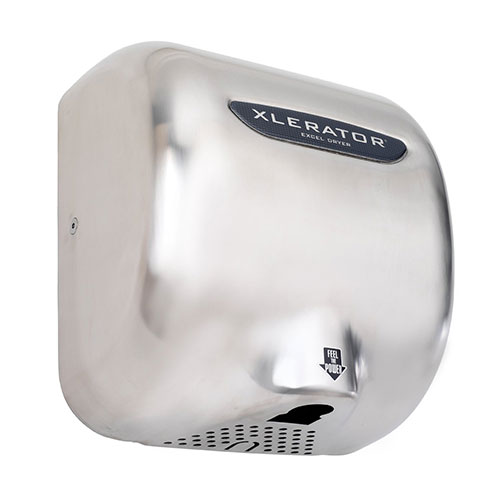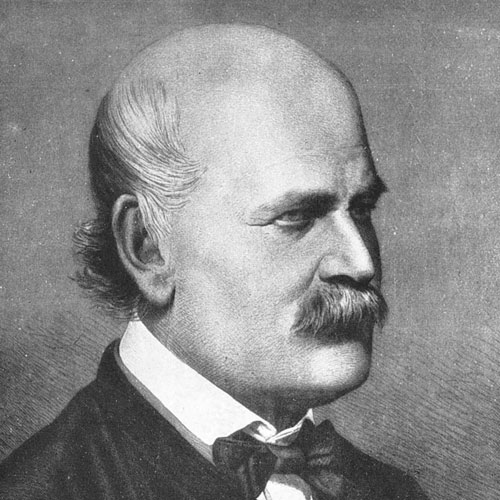This'll Blow You Away
The hand dryer, after a long period of stagnation, has become a hotbed of innovation in recent years. Who knew sanitation could be so forward-thinking?
1921

Hand dryers: racing against the clock
For decades, the greatest downfall the hand dryer was the fact that they were unbearably slow—unable to put forth the amount of warm energy needed to efficiently dry your hands in a few short seconds. It took nearly a minute to properly dry your hands, at which point you might as well have grabbed some paper towels anyway.
World Dryer, the primary company that created the devices prior to the 2000s, had the largest market share for nearly 50 years, but their devices failed to innovate quickly enough, and soon, their competition started to blow them away—literally.
In 1993, Japanese automaker Mitsubishi created a whole new dynamic for hand dryers, offering a hand-dip style of drying that blows water away from your hands rather than completely evaporating it. The Dyson Airblade, released in 2006, took this basic concept even further, though the similarities between the two brands have led to some close competition. (Fun fact: the Airblade's air isn't actually heated.)
But perhaps the mots impressive innovation in the hand-drying space came in 2002. That year, the manufacturer Excel Dryer released the Xlerator, which put a lot of hot air on your hands really freaking quickly, cutting down the drying time to just 10 to 15 seconds (and making a lot of noise in the process). The company's owners invested a massive amount of money in research and development on the device—to the point where they would have folded had it not succeeded—and it paid off as soon as they were able to get people to try the thing at tradeshows.
"Literally we'd have to coax people out of the aisles to come try our hand dryer," Excel Dryer owner Denis Gagnon told NPR in 2013. "So we'd get them up to the Xlerator and they'd put hands under, and you could see the expression in their face; there was a real wow factor to it."
The result is that Xlerators—which you might know as the devices which do this effect to your hands—have quickly taken over the market. In fact, they're actually kinda cocky about it. Upon the release of the Airblade in 2006, Excel director Simeon Barnes said he wasn't even concerned about the new competition.
"There appears to be nothing new or unique about this product and I do not believe it poses a serious threat to our business," Barnes told the BBC.
(That, however, didn't stop Excel Dryer from suing Dyson for false advertising back in 2012.)
$1,349
Five reasons automated hand dryers have become common in restrooms
- Cost over time. Simply put, electricity costs a lot less than paper, and the high initial cost generally pays for itself over the span of a few months. The Environmental Protection Agency did a study of this very issue, using a tribal casino as an example, and found that, even with light usage, a Dyson Airblade would pay for itself in fewer than nine months.
- Improved technology. When hand dryers first came onto the scene, they were loud, inefficient, and weren't very successful at actually dying hands. For much of the devices' early history, only the noise factor was taken care of. But in the last decade or so, the machines have finally started pumping more air in much smarter ways.
- Environmental impact. Hand dryers are often a simple way for a business to prove its environmentally friendly ways to consumers, and the numbers tend to prove they have an effect. A 2014 University of Buffalo study found that, on top of their major cost savings, Airblades also produce 42 percent fewer carbon dioxide emissions than the paper that goes into those rolls of paper towels.
- Sanitation. The devices generally discourage people from touching surfaces with their hands, which is a victory for germaphobes everywhere.
- Maintenance costs. Let's face it; if someone doesn't have to walk into a restroom as often to take out the trash, that's a little less work on that person's plate—because the trash will only need to go out every couple of days, rather than every day. Over time, that small gain cuts down on the amount of overall labor needed.
"I almost didn’t bring this bill because this is not the most consequential bill of the legislative session. We all know that. But nonetheless there are those of us that just find these hand dryers to be extraordinarily obnoxious and disruptive to family members."
— Oregon State Sen. Chris Edwards, discussing a bill he introduced in April that would limit the noise level of hand dryers in bathrooms, along with the speed of the hand dryers. (For those who see this legislation as frivolous, it's worth noting that Edwards' son, who is autistic, used to have episodes as a result of the noises these hand dryers make.) The bill passed the chamber easily, but is currently stuck in committee in the Oregon House.

The doctor who first advocated for proper hand sanitation died a laughingstock
Of course, we wouldn't have a need for all these hand dryers if we weren't actually washing our hands. (Though we imagine some of you aren't, and if that's the case, uh, gross.)
But the sad part about this whole hand-washing affair is that the guy who made the case for proper hand sanitation didn't even earn proper respect for it while he was still alive.
Now, to be fair, Ignaz Semmelweis was kind of a jerk who was famous for a certain level of arrogance. But that doesn't mean Semmelweis was wrong about the necessity of washing one's hands to stop the spread of germs.
Here's the story: Semmelweis, a Hungarian obstetrician, was trying to figure out why the maternal death rate was so much worse for the mothers of babies born in hospitals than it was for those who used midwives. Eventually, he figured out that something might be up with the way that doctors handled their patients.
He didn't know exactly why—while he had an understanding of the basic issues, he used the phrase "morbid poison" to explain what was happening. (It was the spread of Group A hemolytic streptococcus, just an FYI.) Eventually, he figured out that the issue had something to do with the autopsies that medical students were doing on the deceased—just before they were to assist mothers entering the hospital.
Soon, he had the students wash their hands with a chlorine-lime solution before they worked on other patients. And soon enough, the maternal death rates at the hospital dropped.
However, Semmelweis' methods may have shown results, but they proved controversial within the medical community, especially in Vienna, where many doctors considered his theories nonsense—despite the fact that he clearly followed the scientific method. Part of the problem might have been the implication that doctors were unknowingly putting young mothers at risk.
Plus, on top of all that, he refused to actually share his research with the world because he considered the results so obvious. It took him 13 years to finally publish The Etiology, Concept, and Prophylaxis of Childbed Fever, a document which reads as the best told-ya-so document in medical history.
"Since the chlorine washings were instituted with such dramatic success, not even the smallest additional changes in the procedures of the first clinic were adopted to which the decline in mortality could be even partially attributed," he wrote.
Despite his research, Semmelweis died without the respect of the larger medical community—and in an even greater indignity, he died from an infection caused by the very disease he was fighting against.
If he had only made it a couple more decades, he would've known the truth: He was totally right.
The rise of automatic hand dryers has not been lost on paper manufacturers, who have a lot to lose from the Airblade and the Xlerator taking over restaurants and airports the world over.
Kimberly-Clark has in recent years paid for research designed to make paper towels look like the obvious better option. This research generally finds that hand dryers breed bacteria and put the public at risk. Dyson has been quick to call out this research, which is often sponsored by groups like the European Tissue Symposium—a trade group that obviously benefits if paper wins.
Back in 2010, Dyson pointed out that one such study, conducted by the University of Westminster, wasn't peer-reviewed. And a similar 2014 study, also sponsored by the tissue paper trade group, faced similar criticisms. (For what it's worth, the University of Buffalo study we mentioned earlier favored the Airblades.)
As it turns out, this isn't such a cut-and-dried issue.
:format(jpeg)/2018/04/tedium081815_web-compressor_b6uzjx.gif)
/2018/04/tedium081815_web-compressor_b6uzjx.gif)

/uploads/ernie_crop.jpg)